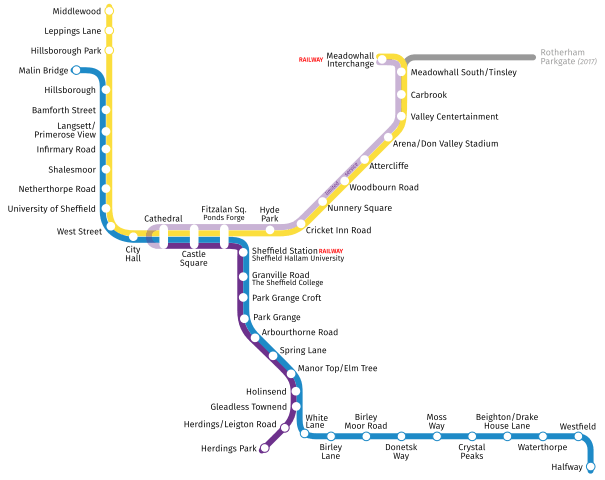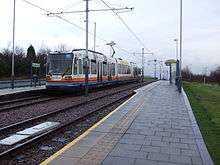Sheffield Supertram
|
| |
|
Siemens-Duewag Supertram in July 2010 | |
| Overview | |
|---|---|
| Owner | South Yorkshire Passenger Transport Executive |
| Locale | Sheffield |
| Transit type | Light rail tram |
| Number of lines | 3 |
| Number of stations | 48 |
| Annual ridership | 11.6 million (2015/16)[1] |
| Website |
www |
| Operation | |
| Began operation | 21 March 1994 |
| Operator(s) | Stagecoach |
| Number of vehicles |
25 Siemens-Duewag Supertram 7 Vossloh British Rail Class 399 |
| Technical | |
| System length | 29 km (18 mi) |
| Track gauge | 1,435 mm (4 ft 8 1⁄2 in) |
| Electrification | Overhead line (750 V DC) |
| Top speed | 50 miles per hour (80 km/h) |
The Sheffield Supertram (officially the Stagecoach Supertram) is an English light rail tram system in the city of Sheffield, South Yorkshire. The infrastructure is owned by the South Yorkshire Passenger Transport Executive, with Stagecoach operating and maintaining the trams. The service commenced in 1994 and currently consists of three lines, named after colours.
History
Following a parliamentary act in 1985 authorising the scheme, the Supertram line was built by the South Yorkshire Passenger Transport Executive (SYPTE) at a cost of £240 million,[2] and opened in stages in 1994/95. It was operated by South Yorkshire Supertram Limited,[3] a wholly owned subsidiary company of SYPTE. In December 1997, the company was sold to Stagecoach for £1.15 million.[4] Stagecoach gained the concession to maintain and operate the Supertram trams until 2024.[5] Patronage has grown from 7.8 million passenger journeys in 1996/97, to 15.0 million in 2011/12.[6] In 2014/15 it carried 11.5 million passengers.[7]
Future
A tram-train extension to Rotherham is currently under construction and is scheduled to open in 2017, with a fleet of seven Vossloh Citylink Class 399 tram-trains in a UK first. This will involve trams operating on Network Rail's Dearne Valley Line from Meadowhall Interchange to Rotherham station with a short extension to Rotherham Parkgate Shopping Centre.[8][9] The proposed station will be a combined tram stop and railway station.[10] It is also planned that Rotherham Parkgate will be the hub for longer distance inter regional services,[11] while Central station will be the hub for local, Yorkshire based services. To cater for the tram train services, Rotherham Central will have a third platform built. It is thought that constructing the station will cost around £14 million (£53 million including the railway service to Leeds) and deliver economic benefits worth over £100 million.[12] A study has concluded that it is not worth expanding Rotherham Central railway station because it would cost £161 million to expand the station but only deliver benefits worth £76 million.[12] This is why constructing a new station is considered more viable.
It is proposed a new Supertram line will be built from Meadowhall to Dore in south-west Sheffield in order to improve connections to the new Sheffield Meadowhall high-speed rail station.[13]
Description


The Sheffield Supertram runs from Sheffield City Centre north-west to Middlewood and Malin Bridge via the University of Sheffield and Hillsborough; north-east to Meadowhall Interchange via Attercliffe; and south-east to Halfway and Herdings Park via Norfolk Park, Manor, and Gleadless. Construction started in 1991 and the first section to open was along a former heavy rail alignment to Meadowhall on 21 March 1994,[5] shortly after the similar Metrolink scheme in Manchester.
The system consists of a mix of on-street running, reserved right-of-way and former railway alignment. The Middlewood and Malin Bridge lines run mainly on the street up to the City Centre; the Meadowhall line runs totally on reserved track – from Attercliffe to Meadowhall it runs on former railway line alongside a freight line to Tinsley Yard and the main line at Rotherham Central. The inner part of the Halfway and Herdings Park lines consist of on-street running, with the exception of the railway station and the viaduct at Granville Road. The Herdings line then runs on reserved track, and the Halfway line crosses the county border into Derbyshire and out again on reserved lines in the countryside. This line also serves Crystal Peaks Shopping Centre.
The three main City Centre stops are located on one side of a former dual carriageway, now a single lane and reserved for buses only. These three stops are served by all routes
Network
The Sheffield Supertram network is organised around Park Square and comprises three lines. The lines, with termini at Meadowhall Interchange, Halfway and Hillsborough, all serve Sheffield city centre and meet at Park Square where a triangular junction was constructed to provide interchange between lines and operational flexibility. Two small branches serving Malin Bridge, from Hillsborough Interchange, and Herdings Park branch out from two of the main lines.

Tram-train services
| Overview | |
|---|---|
| Franchise(s): |
Tram-train operator, not subject to franchising Services to begin in 2017 |
| Main Region(s): | South Yorkshire |
| Other Region(s): | North East Derbyshire |
| Fleet size: | 25 (6 tram-trains on order) (1 in-testing, estimated in service mid-2016) |
| Stations called at: | 48 |
| Route km operated: | 29 |
| Parent company: | Stagecoach |
| Website: | www.supertram.net |
In 2017, Supertram was scheduled to begin operations of the new tram-train line from Cathedral to Rotherham Parkgate, using seven brand new Vossloh-built Class 399 Citylink articulated electric multiple units. The Class 399s are expected to be painted into normal Supertram livery. The existing Siemens-Duewag Supertram fleet will not be upgraded for tram-train operation, so have not been registered under TOPS and cannot be used on the line as they lack the relevant Network Rail safety systems and crashworthiness. The tram-train scheme, which was first planned to be in service by 2015 has been delayed and is not expected to start until the summer 2018.[14][15]
The Class 399 units were built in 2015/16 with the first delivered in December 2015.[16] Until the completion of the tram-train line, some will be used to provide increased capacity on the existing Supertram network.
SupertramLink bus services
Two special Stagecoach Sheffield bus services connect with the tram, providing additional journey opportunities:
- SL1 runs from Stocksbridge to Middlewood, the north-western terminus of the yellow route
- SL2 runs from Stannington to Hillsborough or Malin Bridge, the northern terminus of the blue route
SL3 ran from Killamarsh to Moss way via Crystal Peaks and has now been replaced by No.72
Through tickets are available to allow travel on Supertram and SupertramLink services.
Tram stop list
Technical data

The fleet
The Supertram network operates a fleet of 25 three car trams built by Siemens-Duewag of Düsseldorf, Germany in 1992. The trams are capable of carrying 88 seated and 155 standing passengers and are 40% low floor design, the vehicles have been specially designed for gradients as steep as 10%. In the 1980s a design choice was taken to create the longest possible vehicle to avoiding multiple working[17] which resulted in a 34.8-metre (114 ft) design, the third-longest tram design in operation in Europe at the time[18] and the longest in service in the UK until the 42.8-metre (140 ft) long Edinburgh Trams were introduced.
Launched in an initial light grey livery, following the takeover by Stagecoach the trams were reliveried in Stagecoach's corporate livery from 1997. From 2006 the trams were refurbished, and a new dedicated Supertram blue–based livery was launched, rolled out by 2008.
Vossloh is to supply seven tram-train vehicles with the first delivered in December 2015.[16]
| Class | Image | Top speed | Number | Built | Unit nos. | Notes | |
|---|---|---|---|---|---|---|---|
| mph | km/h | ||||||
| Supertram |  |
50 | 80 | 25 | 1992 | 101-125 | |
| Citylink |  |
68 | 110 | 7 | 2015 | 201-207[lower-roman 1] | |
The track

The network is 29 km (18 mi) long, with 60 km (37 mi) of track.[19] It features two types of track; tramway track where either pedestrians or road traffic share the right of way and ballasted railway track when there are no such requirements. Tramway track consists of a grooved tramway rail set into a concrete base with troughs into which the rails are laid. Most of the track is on-street using 35G-section grooved tram rail, with BS11-80A 80 lb/yd (39.7 kg/m) flat-bottom rail elsewhere.[19] The railway track was supplied by British Steel Corporation Track Products of Workington and laid on sleepers consisting of concrete blocks with steel ties which gives a spring feeling when travelling on these sections. The track is laid on a bed of ballast which in turn rests on a prepared formation. Street crossings are usually laid with grooved tramway rails.
The overhead wiring
Supertram is powered through 12 electric substations and fed through 107 mm2 (0.166 sq in) diameter overhead line equipment (OHLE) wire.[19] The substations convert the 11 kV AC supply into 750 V DC supply into the overhead. The 12 substations are situated as follows:
- Blackburn Meadows
- Carbrook
- Nunnery Square
- Park Square
- Arbourthorne
- Gleadless Townend
- Birley
- Crystal Peaks, Ochre Dyke Lane
- Halfway, Eckington Way
- University, Brook Hill
- Langsett Road, Capel Street
- Middlewood
The overhead line equipment depends on the location. If the tracks are close together, central poles with 'steady' arms on each side are used. If the tracks are further apart, poles on either side with span wire are used. With aesthetics in mind a minimum number of traction poles are used and whenever possible the wire is anchored onto neighbouring buildings. Supertram, Sheffield City Council and landlords were in talks to try and hide anchor points as much as possible and blend them into the structures.
The contact wires are twin cadmium copper ones, twin wires being necessary because of the high installed power rating of the trams (1 megawatt). The regenerative braking on the tram feeds current back into the wires.
Operation

The rules of operation of the Sheffield Supertram are similar to those of a traditional railway. Unlike normal trains, tramways can be operated without signalling, although block signalling is sometimes necessary on single-line sections. The trams are driven on a line-of-sight basis, so that the tram can be stopped if an obstruction is spotted ahead.
Signals, however, are used to give indications to tram drivers when running on-street and at street crossings. As trams have priority at many places, it was necessary to give them different traffic light phases from motor traffic and therefore different types of indication have to be used from those applicable to motor vehicles. Signal phases for the tramway are specifically modified to account for the length of the tram. The tram signals are usually operated alongside and in conjunction with traffic signals. Signals consist of white lights arranged vertically (for go), horizontally (for stop) and a cross (for caution). Two other light arrangement indicate a point direction at junctions. The five white lights are distinct from those of the standard road traffic lights or railway line-side signals.
Tramway signals
 Proceed.
Proceed. Stop.
Stop. Caution and proceed.
Caution and proceed. Turning left and proceed.
Turning left and proceed. Turning right and proceed.
Turning right and proceed.
Junction signals
 Points set for left.
Points set for left. Points set for right.
Points set for right. Points misaligned or not detected.
Points misaligned or not detected.
Points indicators are provided at junctions to indicate the route which is set through the points. At junctions, where Supertram and train movements can conflict with road traffic, fixed signals are provided in addition to points indicators. A points indicator may only be passed if it displays the correct route indication for the tram concerned and, where fixed signals are provided, if both points indicators and fixed signals are set for the correct route.
Line-side signals give instructions or warnings to tram drivers. To distinguish them from normal road signs, they are diamond-shaped. The most common are speed restrictions which are in miles per hour. These are particularly necessary on road-running where trams travel along with road traffic.
The route a tram is to take is computer-controlled. The route is set on a device in the tram before a journey is started, and on approach to junctions, a signal is sent from the tram to a device known as a VIS loop buried beneath the track. This automatically sets the points in the correct direction.
The depot

The depot is located at Nunnery Square and occupies the former carriage sidings alongside the Sheffield-Lincoln railway line. It was designed and constructed by Balfour Beatty on 2.6 hectares (6.4 acres) of land and consists of a three-line workshop building, six stabling sidings, a turning loop, engineers sidings and sundry equipment. The main offices and reception, supervisor's offices, plant room, staff mess rooms, paint shop, first aid are on the first floor level on the South side of the building. The south-west of the building is home to the Operations and Power Controller's office, where live control of the running of the service is monitored using SCADA, CCTV and radio contact. The depot substation is also located in the south-west corner, two 600 kVA transformer-rectifiers supply the tramway overhead and an 800 kVA transformer feeds the depot facilities.
In the workshop itself are two through-running lines (numbered 8 and 9) and line 10, a stub end. All lines have inspection pits and line 8 possesses a Hegenscheidt wheel lathe. This machine allows wheel turning whilst both sets of doors are closed. The wheelsets are turned in situ. High level access is provided on lines 9 and 10 for servicing of equipment boxes and pantographs. An automated washing machine is located on line 7.
The site's security is provided by CCTV and fence guarding and is under control of security personnel housed in the operations centre. Road access is from Woodbourn Road at the end of the depot.
The site was, before the arrival of Supertram, already dedicated to the railway industry, Nunnery engine shed filled most of the site whilst lines of the Midland Railway, Great Central Railway and London & North Eastern Railway irrigated the area and served collieries.
Tram stops

Forty-eight tram stops have been built to permit users accessing the Supertram.[20] These are generally found to be 26.5 m (87 ft) in length and 3 m (9.8 ft) in depth and are of a network-wide standard making them easy to understand and use. The design incorporates recommendations made by the Cranfield Institute of Technology who studied ergonomics for both able-bodied and disabled users.[21]
Tram stops are elevated at 37.5 cm (14.8 in) with a 1:20 slope. The platform edge comprises a 60 cm (24 in) wide and light coloured textured paving with strips of 40 cm (16 in) wide edge warning tactile strip. Directional guidance tactile paving crosses the width of the platform to coincide with the tram door locations.
Notable structures
The Supertram network possesses a few remarkable structures. Two viaducts and one underpass are of interest: the two viaducts carry Supertram onto Park Square (a major road junction in the centre of the city), one of them being a six-span viaduct, the other the bowstring steel arch Park Square Bridge. The underpass takes the tram underneath the busy A57 roundabout outside the University of Sheffield.
Ticketing
Until the Stagecoach takeover, ticketing was done via ticket machines provided by Abberfield Technology of Australia. These blue ticket machines dispensed adult single ride tickets, senior citizen concessionary tickets and child concessionary tickets. As well as singles, the machines sold multi-packs at a discount. Fare tables were shown on the machines with the validity of the different prices.
To travel, each ticket had to be validated in a yellow machine on the platform. The ticket defined the type of passenger and trip as tickets do now. On validation, an overprint was added, giving the tramstop code, time and date of validation and the point of validation.
As the machines did not dispense change, nearby shop-owners were often asked for change to purchase tickets from the machines. There were also problems with machine reliability. When Stagecoach took over South Yorkshire Supertram it removed the ticket machines and began selling tickets on board. This meant improved staff presence on board and tickets could be systematically checked.
Stagecoach Sheffield period tickets are valid on the trams and on Stagecoach buses, and period South Yorkshire PTE tickets covering Sheffield or the whole of South Yorkshire are valid on Supertram as well as buses and trains.
Unlike some other tramway and light rail operators in England, Supertram accepts concessionary travel passes issued by any English local authority.[22]
Opening dates
- 21 March 1994: Fitzalan Square to Meadowhall
- 22 August 1994: Fitzalan Square to Spring Lane
- 5 December 1994: Spring Lane to Gleadless Townend
- 18 February 1995: Fitzalan Square to Cathedral
- 17 February 1995: Cathedral to Shalesmoor
- 27 March 1995: Gleadless Townend to Halfway
- 3 April 1995: Gleadless Townend to Herdings Park
- 23 October 1995: Shalesmoor to Middlewood/Malin Bridge
Incidents
The Supertram network has been accused of increasing the dangers of roads in the area, particularly in wet weather.[23]
- In 1995, engineer William Roe suffered severe brain damage after his car skidded on wet tram tracks and crashed into a metal pole. Supertram were made to award Mr Roe compensation for failing to ensure that the rails were level with the adjacent road surface, and for the lack of warning signs indicating that the tracks are hazardous when wet. It was reported there were 53 accidents involving Supertram in Sheffield between 1994 and 1997, including two fatalities and 12 serious injuries.[24]
- A man died in 2003 from serious head injuries after he was hit by a tram whilst lying on the tracks.[25]
- However, there has been only one serious or RAIB reportable accident since the 2003 incident;[26] this was in 2005 and was caused by a pedestrian stepping in front of an approaching tram,[27] which is the lowest of any UK tram network.
- In October 2015, trams 120 and 118 collided at Shalesmoor. This resulted in the 2 damaged sections of both trams requiring major repairs, whilst the undamaged parts of trams 120 and 118 were put together and painted in a version of the original Sheffield Tramways cream and blue livery to re-create the original 120. This has resulted in the fleet being reduced from 25 to 24 trams with no tram numbered 118 currently in service at any time.
See also
- Sheffield Tramway – the original Sheffield tramway system.
- Light Rail Transit Association
- List of town tramway systems in England
- List of town tramway systems in the United Kingdom
References
- Notes
- Citations
- ↑ "Light Rail and Tram Statistics: England 2015/16" (PDF). gov.uk. Department for Transport. 7 June 2016. Archived (PDF) from the original on 12 July 2016.
- ↑ "Sheffield Supertram information". BBC South Yorkshire. BBC. Retrieved 11 March 2009.
- ↑ Companies House extract company no 2634683 South Yorkshire Supertram Limited
- ↑ Sheffield supertram falls victim to competition from cheap buses The Independent 10 June 1996
- 1 2 Courtenay, Peter. "Sheffield Supertram: History". TheTrams.co.uk. Retrieved 19 August 2007.
- ↑ "Light rail and tram statistics: 2011/12". Government Digital Service. 19 July 2012. Table LRT0101
- ↑ "Light Rail and Tram Statistics: England 2014/15" (PDF). www.gov.uk. Department for Transport. Retrieved 19 September 2015.
- ↑ Rotherham tram-tram project funding confirmed Railway Gazette International 17 May 2012
- ↑ "New 2017 hope for delayed £60m Sheffield to Rotherham tram-train scheme". The Star. Retrieved 27 March 2015.
- ↑
- ↑ http://www.rothbiz.co.uk/2015/10/news-5512-new-station-for-rotherham.html
- 1 2 http://www.yorkshirepost.co.uk/news/rotherham-could-get-new-rail-station-1-7501605
- ↑ "Sheffield Star-New Sheffield supertram line". Retrieved 28 January 2013.
- ↑ "Sheffield to Rotherham tram-train scheme delayed by year". BBC News. 2015-10-08. Retrieved 2016-11-26.
- ↑ "Sheffield to Rotherham tram-train scheme delayed further". BBC News. 2016-11-25. Retrieved 2016-11-26.
- 1 2 First tram-train heads for Sheffield Railway Gazette International 20 November 2015
- ↑ http://www.supertram.com/uploads/Designingourtrams.pdf
- ↑ http://www.supertram.com/uploads/vehicleinfo.pdf
- 1 2 3 "About us: Technical". Stagecoach Supertram website. Retrieved 19 August 2007.
- ↑ Courtenay, Peter. "Sheffield Supertram: Facts and figures". Retrieved 19 August 2007.
- ↑ "About us: Access". Stagecoach Supertram website. Retrieved 19 August 2007.
- ↑ "Stagecoach Supertram Ticket Information". Stagecoach Group. Retrieved 4 January 2010.
- ↑ http://www.irwinmitchell.com/news/Pages/sheffield-lawyer-tram-accidents.aspx
- ↑ Stokes, Paul (25 October 2001). "Tram firms face big claims after crash case". The Telegraph. Retrieved 27 November 2014.
- ↑ "Man dies in Supertram accident". BBC News. BBC. 8 March 2003. Retrieved 27 November 2014.
- ↑
- ↑ http://www.raib.gov.uk/cms_resources.cfm?file=/060301_R012006_StaniforthRoad.pdf
External links
| Wikimedia Commons has media related to Sheffield Supertram. |
- Supertram website
- Stagecoach Supertram at thetrams.co.uk
- Collection of Google Earth locations of Stagecoach Supertram stops (Requires Google Earth software) from the Google Earth Community forum.
- Supertram specs
